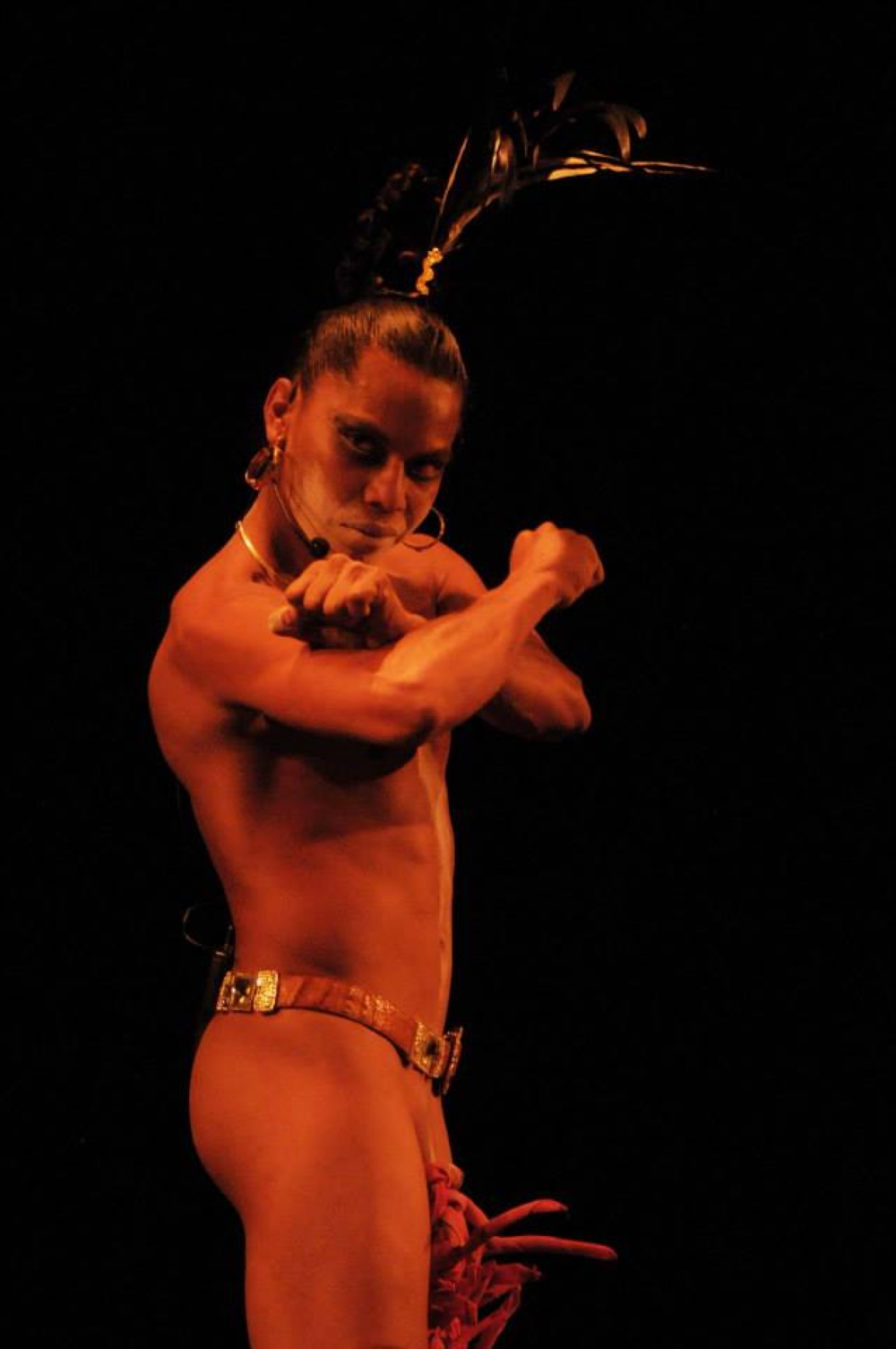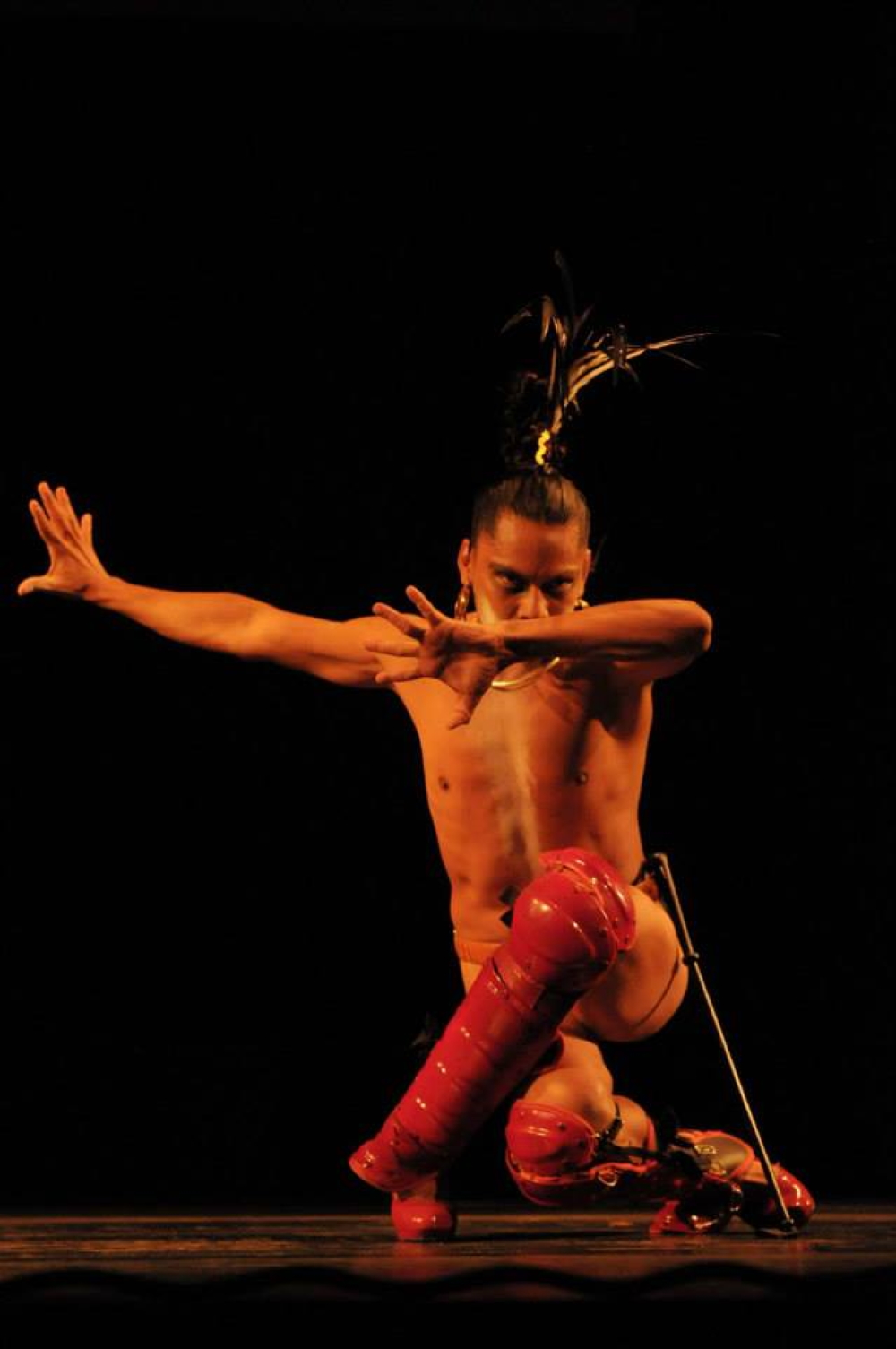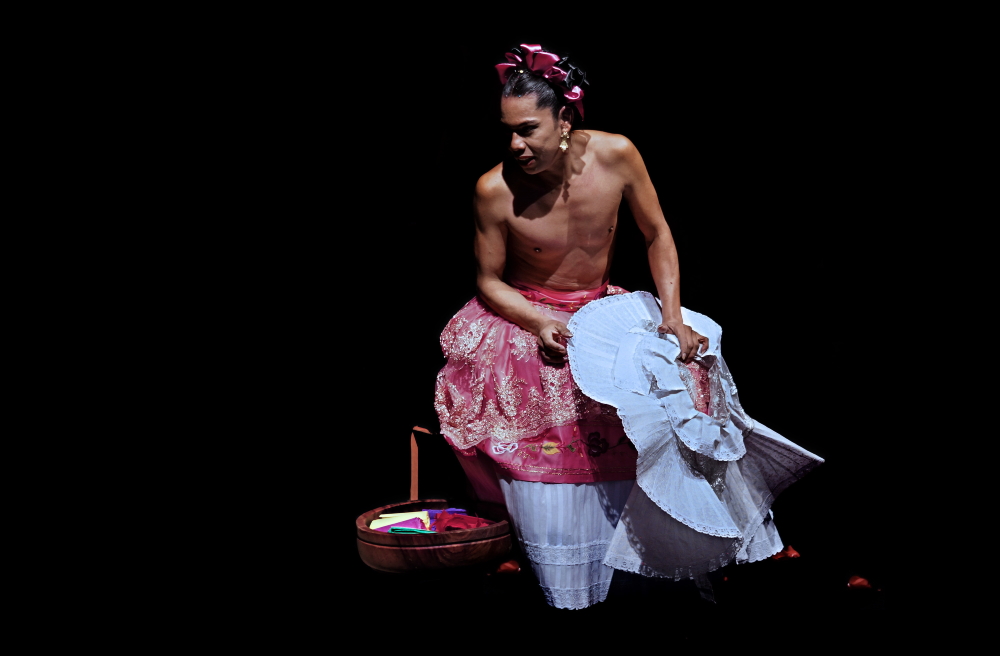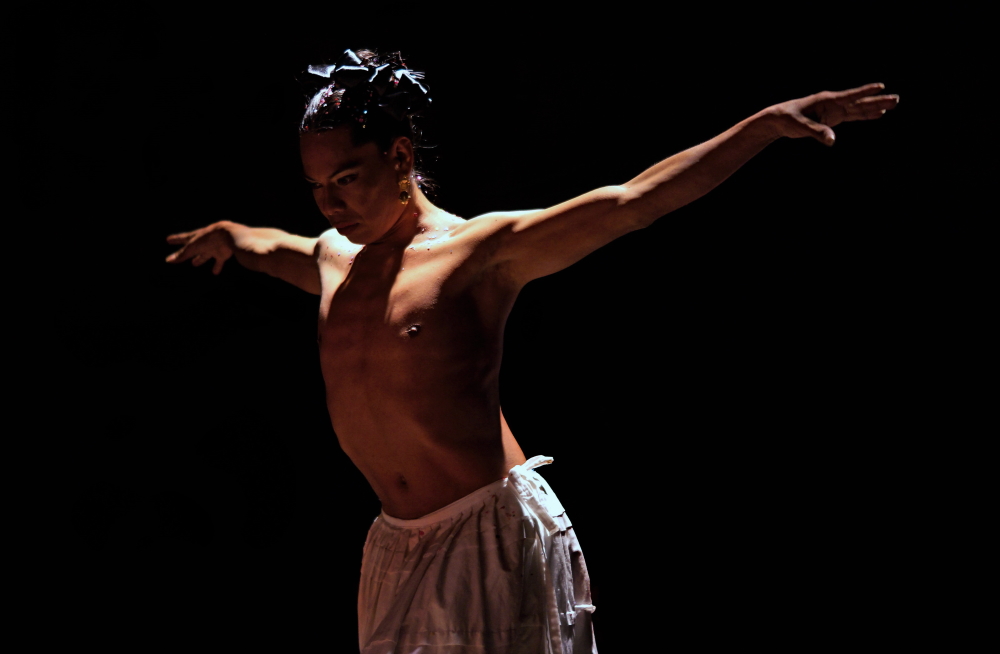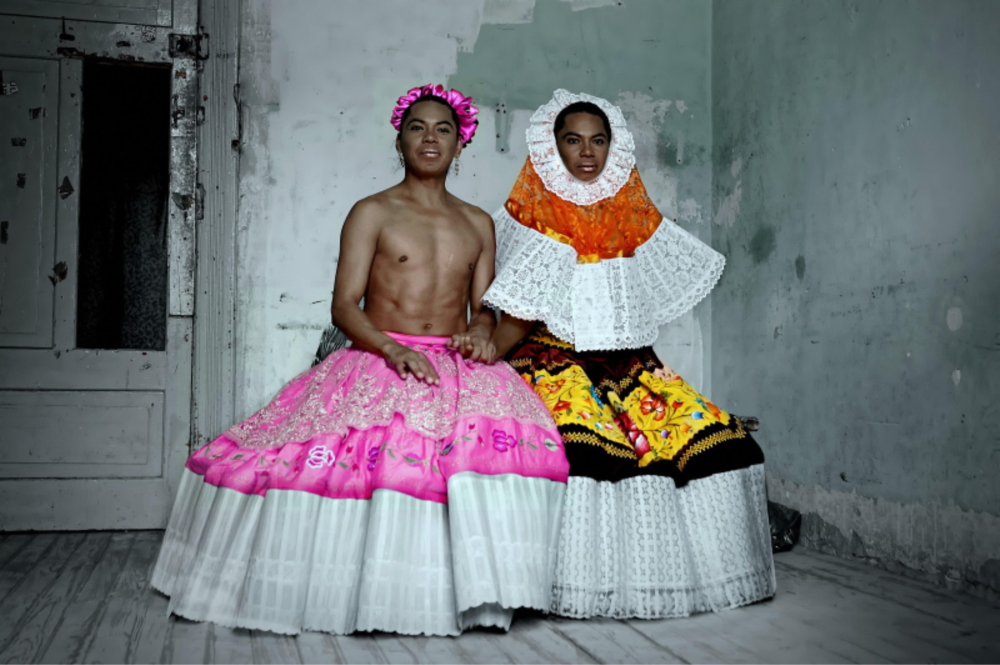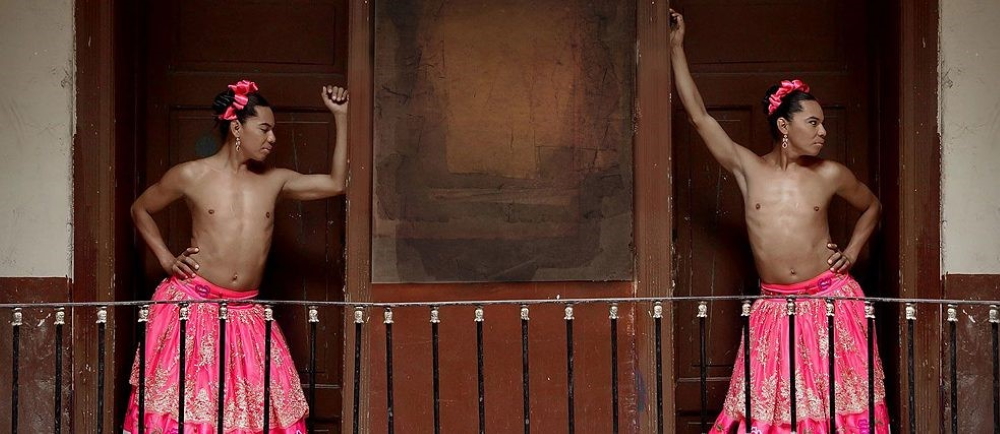Lukas Avendaño
performance artist / actor / dancer / poet
Mexico
A speciality in the colorful and dazzling world of creativity is presented by this internationally known Mexican performance artist, actor, dancer and poet. „He belongs“, according to Wikipedia, „to the indigenous ethnic group of the isthmian Zapotecs (Binnizá). This people knows three social genders: women, effeminate men/muxes' and masculine men. Lukas Avendaño, a studied anthropologist, belongs to the socially integrated minority of the Muxe' and addresses their situation in his works. He integrates nationalist-Mexican elements as well as issues of modern Western-style homosexuality into the ethnicist discourse of his performances, creating an interesting hybrid.“
Lukas Avendaño
performance artist / actor / dancer / poet
Mexico
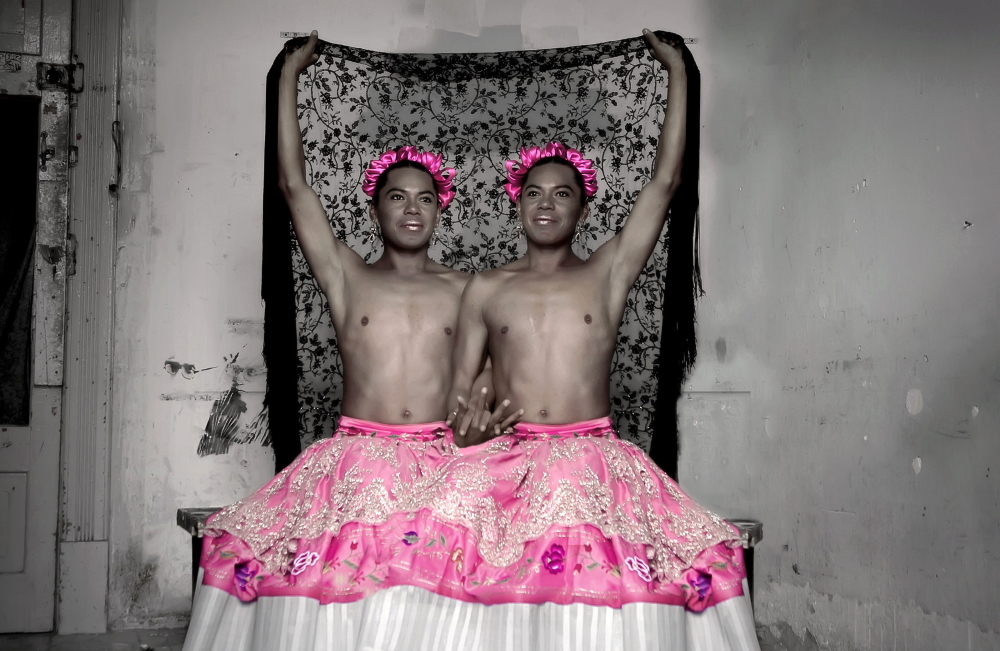
"Lukas Avendaño's performances, for example, depict the androgynous beauty of muxe'tum in female costume but with the male torso exposed.“ This is a quote from photographer Stefanie Grand, who did her doctorate in postcolonial and gender studies on the gender relations of the Binnizá people, in a story on hybrid identities of human beings between globalization and ethnicity. „Moreover, with the help of the metaphor of the 'Berelele' - a tameable wild bird that dies in captivity if kept alone - he criticizes the practice that 'muxes' are not allowed to have permanent partnerships. In the performance ‚Requiem for an Alcaraván‘, the artist thus addresses the muxes' longing for a permanent partnership or husband (marido). Dressed in the traditional costume of isthmian women, which also became known in the West through Frida Kahlo, he incorporates the typical stations in the lives of women at the Isthmus, who are falsely labeled matriarchal, and, as a male bride, criticizes the restrictive gender norms of his society.“
Lukas Avendaño (* 1977 in Tehuantepec, Mexico) studied anthropolgy at University Veracruzana and finished it with a bachelor’s degree in 2010. „At the same time, he began to study modern and folkloric dance and trained as a dancer for ten years. Besides his artistic activity, Señor Avendaño teaches dance and was the cultural attache of his hometown“ (Wikipedia). The list of his international engagements includes performances in Columbia, Argentina, USA, Canada, Germany, Switzerland, Spain and Ecuador. ‚La Peña cultural Centre‘ in Berkley (California) has described one of Lukas Avendaño’s performances this way: „His cross-dressing performance interweaves ritual dances with autobiographical passages and actions that involve audience members, in order to challenge the widely held view of a gay-friendly indigenous culture and point towards the existence of lives that negotiate pain and loneliness with self-affirming pride.“
In the LA Times‘ review headlined „an immersive show challenging the gender binary combines dirt and a futuristic soundscape“ (featuring Lukas Avendaño) the Mexican is quoted: „You start to live in the space and the time. Every time we run through the piece, I feel like we’re doing a healing ritual.”
Since 2006 he works for ConArte Mexico, a civil society organization dedicated to promoting arts education in schools.
Lukas Avendaño lives in Tehuantepec, Oaxaca (Mexico).
de-de.facebook.com/people/Muxe-muxhe-performer-Lukas-Avenda%C3%B1o/100037424539546/?sk=about
Interview January 2023
The third sex: artistic activity as a healing ritual
INTUITION/IMAGINATION
How does intuition present itself to you – in form of a suspicious impression, a spontaneous visualisation or whatever - maybe in dreams?
I consider that the assertive in intuition is the attention or the protagonism that you want to give to the way in which intuition manifests itself, in that sense depending on the circumstances and urgencies is how I deal with this intuition: If not urgent, I give myself time to explore it from associations, deductions and/or documentation, once I can play with these premises, I can dare to suggest, not an answer/proposition, but a possibility that can suggest multiple answers or possibilities as hypothetical premises.... I dare to enunciate this procedure as an exercise of the "archeology of memory", which can be traced in the "specific memory" of the species, the "ethnic memory", of the cultural group to which one ascribes, and/or the "virtual memory", as an idea or a hypothetical premise, which in my case leads me to concretize it in a scenic piece.
Will any ideas be written down immediately and archived?
Yes, as archives, without that meaning that it is that first idea that will reach the viewer. In the specific case of LEMNISKATA, what we can witness is variation number six, which is the sum of the five previous variations. The five previous variations are the result of my experiences, my impressions, my documentation, my readings and above all the reflections that lead me to each of these "sentimentals" - this is a compound word that arises in the context of fieldwork, and is composed of that which comes from the senses and feelings - individually or between tissues.
?: How do you come up with good or extraordinary ideas?
I think that in the specific case of the scene, there are no good or extraordinary ideas, they are just ideas, since the qualitative value of being a good or extraordinary idea is left to the audience.
For the case of the scene, I don't start from ideas; I sacrifice the idea for the urgent - the necessary, where the radar of this dichotomy: urgent/necessary, is the humanitarian. I am concerned and occupied by the humanitarian crisis the country is going through, the forced disappearances, the low intensity war: bodies hanging from bridges, the headless in the public space, bodies piled up on the highways. And despite this, I try to ensure that the scene does not bear the stamp of catastrophe, but that the aesthetics celebrates life, resistance, civil disobedience to any inhuman order. History is not always a chronological idea, but images that are perpetuated in ideas, and that is what I try a little, without knowing if I succeed. May images remind us of our history so as not to repeat it.
Are great ideas based on intuition and do they reveal themselves in a kind of clear as well complete version that just has to be realized? Or is it endless trials and errors (after the first spark) that result in constant developments up until the final result?
At this time when information is almost immediate, I consider that intuition deserves to be accompanied by information that paradoxically, in the case of the scene, does not prioritize rationality, but rather "sentimentality". Regarding clarity, I like to think on the contrary, the degree of opacity/darkness will come from the disposition of the pieces on the board, as tactics and strategy for some people may be associated with the vocabulary of war, and I like to imagine that the day may come when these are associated with a culture of peace.
What if there is a deadline, but no intuition? Does the first fuel the latter maybe?
Intuition, we will always have intuition, is what has brought us to this place as a species, as humanity. If we start from the etymology of the word intuition always leads us to "observe, consider", "look inside". Here the difficult thing is not that we lack intuition, but rather we have too thick a layer that always invites us to distrust what we feel, what we believe. And on the contrary we are insisted that we can only trust what is quantifiable, what has a material referent, what is written or what can be scientifically proven... everything else deserves our distrust, our suspicion.
Because of this, I consider that when someone invites us to mistrust our intuition, my question to ask myself is: Who benefits from my mistrust? Who is strengthened by my mistrust? Who gains from my mistrust? Who accumulates more power from my mistrust?
This reminds me of when my computer was stolen from my backpack in the administrative offices of the university, and the director said to me, "You trusted Lukas", to which I replied, "I did not trust, someone has abused my trust, because I cannot go around the world distrusting everyone..."
INSPIRATION
What inspires you and how do you stimulate this special form of imaginativeness?
It motivates me to find possibilities of falsifying the "criteria of truth", it motivates me the possibilities of exposing the contradictions of the "absolute truths", it excites me when I can make the one who installs himself as the truth see that this truth placed in the specialty and the dilated temporality loses balance. It is as if we leave to the time of the "long duration" the ideas that we have of America, Europe and it would lead us not to forget that they are inventions, like so many things today, and for which there are still so many conflicts.
How do you separate the good from the bad and which ideas are worthwhile to be explored further or whether one idea has the potential of being outstanding really?
The good and the bad are inseparable, because they have a common origin which is morality: now we know that morality is temporal, relative and historical, I have just announced three theses.
T 1.- "Good and bad are inseparable"
T 2.- "have a common origin".
T 3.- "morality".
From these three theses three ideas emerge that can lead us to carry out a deep documentation and reflection, from which it would result that either any of the three theses are false, all of them are false or all of them are true. For my scenic exercise I like to play more with the idea of "fairness" and its importance and/or urgency.
Has it to appeal to you primarily or is its commercial potential an essential factor?
Neither of the two, I consider that the attraction factor and the commerce factor is outweighed by the risk factor, I am excited about what involves risk.
Do you revisit old ideas or check what colleagues/competitors are up to at times?
If by old ideas I mean "archeology of memory", yes, for example in the specific case of LEMNISKATA I intend the staging of our uroboric psyche, our ethnogenetic subjectivity, the memory of our ancestry, a tribute to the archetype of the female, the incommensurability that gives birth to our own existence. LEMNISKATA seems to me a ritual of atonement to the women of the world.
CREATIVITY
Which time/place/environment suits your creative work process the best (tranquillity or pressure) and which path do you take from theory/idea to creation?
Solo hikes, riding bikes alone, and occasionally exchanging views, ideas, thoughts, with someone with the ability to reply, question, or suggest sources. I like to have references, as I would not like to appeal to ignorance of the laws in my defense.....
What is better in the realization process: speed and force creativity i.e. grasp the magic of the moment, or a slow, ripening process for implementation/elaboration?
I have pieces created under the two methodologies forcing creativity, and others that carry a systematic documentation, when I have a team in the project I try to use the format of the documented, reflexive process, since I try not to forget that my neurotic structure is not the same as all the others that integrate the team. However, I try to channel, channel and provoke people to deliver their cultural and intellectual capital, their talent, their "grace - gift".
How important are self-doubt and criticism (by others) during such a process i.e. is it better to be creative on your own, only trust your own instincts, or in a team?
When working as a team it is essential that doubt and criticism appear, I believe that this is how clarity is achieved in the ideas that are proposed and confidence is born in those who "agree" these ideas in the scene.
I rarely have the opportunity to develop projects with a multidisciplinary team, and when this happens I am grateful for it. My work with greater trajectory has happened in isolation, since in a rural community it is complicated to have the interlocution of professionals or specialists in the area of the scene, not so we have specialists in producing corn, banana, sesame, knowledgeable in planting and harvesting in lands without irrigation system.
Should a creative always remain true to him-/herself including taking risks & going against the flow or must one, for reasons of (commercial) survival, make concessions to the demands of the market, the wishes of clients and the audience’s expectations?
I am fortunate that until today I have not had to subject myself to the laws of supply and demand, perhaps because I do not visualize my work as commerce. I can consider myself quite free in terms of my time to create, and perhaps that makes my productions have enough space between one and another.
Examples:
Ixmukané / September 2022 (solo)
Lemniskata / July 2022 (cast)
Xibalbay / August 2021 (cast)
I am not a Person. I am Butterfly / May 2014 (solo)
Requiem Para un Alcaraván / June 2012 (solo)
How is innovation still possible if one has established a distinctive style and, just in case, is it good to be ahead of one’s time even one hazards not being understood?
I consider that it is a bit like what happened with LEMNISKATA, the Mexican public has been accustomed to my solos, where I am the choreographer as well as the performer. And that's why LEMNISKATA seems to some people overwhelming, others boring, but it doesn't worry me, I have hope that even from boredom can emerge something that helps reflection, I think that boring images can haunt us like nightmares, like the images of horror, migration, or beauty.
When does the time come to end the creative process, to be content and set the final result free - or is it work-in-progress with an endless possibility of improvement?
When they are my solos, there is always a possibility of making a new change, of line, lighting, costumes, props, text, choreography; on the other hand, when they are group casts it is a little more complicated because of the time investment, but that does not mean that one more variation can be made.
SUCCESS
Should/can one resist the temptation to recycle a ‘formula’ one’s successful with?
I love to accept challenges, I love to be asked unusual questions, it stimulates me to imagine answers that I do not have, or had not thought of, and that is the richness of my life, learning, rediscovering, and solving with creativity, perhaps that's what I like most about my job, suggesting a different answer. And this answer also tried to suggest it in the scene, in method as in result.
Is it desirable to create the ultimate/timeless work, but doesn’t “top of the ladder” bring up the question of “what’s next?” i.e. isn’t such a personal peak “the end”?
Well, finding the timeless seems to me a great challenge, I am aware that my creations are temporary, they are bathed in contextual signs and symbols: from the music to the stage space itself is temporary, I consider that the challenge is to find the balance, perhaps the most eloquent timeless wink is the nudity of the bodies, since this has easily changed very little in the last ten million years. And we are here, trying to build loving, joyful relationships, trying to live harmoniously and peacefully.
MY FAVORITE WORK:
Regarding your question about my favourite work: As a result, each one is special because its birth responds to the questions, reflections or defensive acts that it took in the face of being cornered, "armed peace" or "peace after the encirclement". As a process: I like it when, through the execution of the scene, it manages to violate the spectator's armour, when the scenic action fissures, tears, cracks, destabilises or falsifies the spectator's criterion of truth. As a kind of luck where the symbolic framework that sustains the imaginary of those who see me on stage begins to rock as if it were a hammock, not to lull them to sleep, but to make them feel the vertigo... and not necessarily because the spectator's perception or mine are true, but because each one has the possibility of falsifying even themselves.
